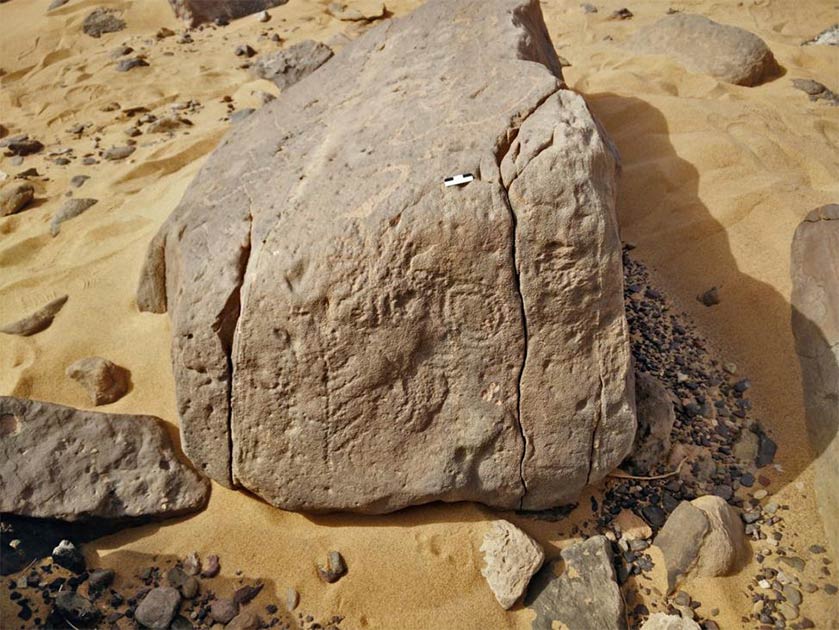‘Scorpion King’s Domain’: The Oldest Place Name Sign in the World
The oldest place name sign in the world has been found in Egypt. The inscription, which was etched into a rock in Wadi el Malik east of Aswan, dates back to the late fourth millennium BC. It names the location as part of the “Domain of the Horus King Scorpion.”
Discovering the Oldest Place Name Sign in the World
Researchers from the University of Bonn in Germany discovered the oldest place name sign while they were teamed up with Abdelmonem Said and Mohamed Abdelhay of the Aswan Office ("Taftish") of the Egyptian Ministry of Antiquities. They found the rock bearing the hieroglyphs just over two years ago, according to a University of Bonn press release. The team has also identified Neolithic rock carvings in the area as well.
The rock bearing the oldest place name sign has four hieroglyphs on it. When the team deciphered the inscription they found the name ‘Scorpion’ and a circular hieroglyph, which indicates that this is a place name. Taken together, the inscription reads “Domain of the Horus King Scorpion.” Egyptologist Professor Dr. Ludwig D. Morenz from the University of Bonn, declared that “This makes it the oldest known place name sign in the world.”

Drawing of the four hieroglyphs: The circular sign at the end indicates that this is a place name. (David Sabel)
Who was the Scorpion King?
Morenz also says in the press release “This ruler called 'Scorpion' was a prominent figure in the phase of the emergence of the first territorial state in world history.” King Scorpion lived and ruled sometime around 3070 BC, although the exact dates of his reign are unknown.
- The Forgotten Stones of Aswan Quarry, Egypt
- The Head of an Emperor, the Shrine of a God: Two Contrasting Finds at the Egyptian Sites of Luxor and Aswan
- The Great Abu Simbel Rescue: The Tale of Two Ancient Temples That Moved Up A Hill
Much of the ruler’s life is a mystery, however a previous Ancient Origins article explains that King Scorpion’s kingdom had political and economic ties to Mesopotamia. The ruler may also be the man wearing the white crown of Upper Egypt and holding a hoe on the Scorpion Macehead, an artifact which was found at Hierakonpolis and dated to the Late Predynastic - Early Dynastic period. Small ivory tags and stone and clay vessels have also been found over the years with the king’s name on them. Finally, rock art at Gebel Sheikh Suliman may also depict the victory of the king over his Nubian enemies.

Left: The Scorpion Macehead, Ashmolean Museum (CC0). Right: Drawing possibly depicting the Scorpion King on the macehead. (CC BY SA 3.0 de)
A Land Divided into Domains
According to Morenz, Egypt had the first territorial state in the world. “There were already ruling systems elsewhere before, but these were much smaller,” Morenz says “In fact, several rival population centers merged into the new central state.” Socio-economic dependencies and exploitation of different realms ruled by the king already existed in the developed administrative system of the fourth millennium. The economic entities, known as domains, were subject to taxes and duties.
“The boundaries between symmetrically and asymmetrically conceived dependencies seemed to be rather fluid at the time,” Morenz says, suggesting that a give-and-take-system sometimes seemed to unexpectedly shift into a heavily exploitive one.
The University of Bonn press release says that the oldest place name sign isn’t the first example of a named domain. Over the years, domain names have been found on cylinder seals, delivery labels, and labels on ancient containers. However, the researchers say that the inscription found on the rock in Wadi el Malik “makes such a royal domain tangible as a concrete archaeological place for the first time.”
More to Discover
Morenz says that the rock’s inscription holds value beyond it’s significance as the oldest place name sign in the world; it is also important since it is one of only a few sources from the region hinting at the political, social, and economic conditions which people were living in five thousand years ago. It’s also unusual for writing to be found in such remote locations in the fourth millennium BC. Taking these factors into account, Morenz says, “For the first time, the process of internal colonization in the Nile Valley becomes more visible by writing.”
According to Morenz, the archaeological investigations are still in their “early stages” in the area and the researchers can expect to find more fascinating finds there in the future.

The research area Wadi el Malik east of Aswan with figures engraved in rock. (Ludwig Morenz)
Top Image: The oldest place name sign in the world – a rock inscription with four hieroglyphs declaring "Domain of the Horus King Scorpion". Source: Ludwig Morenz

















